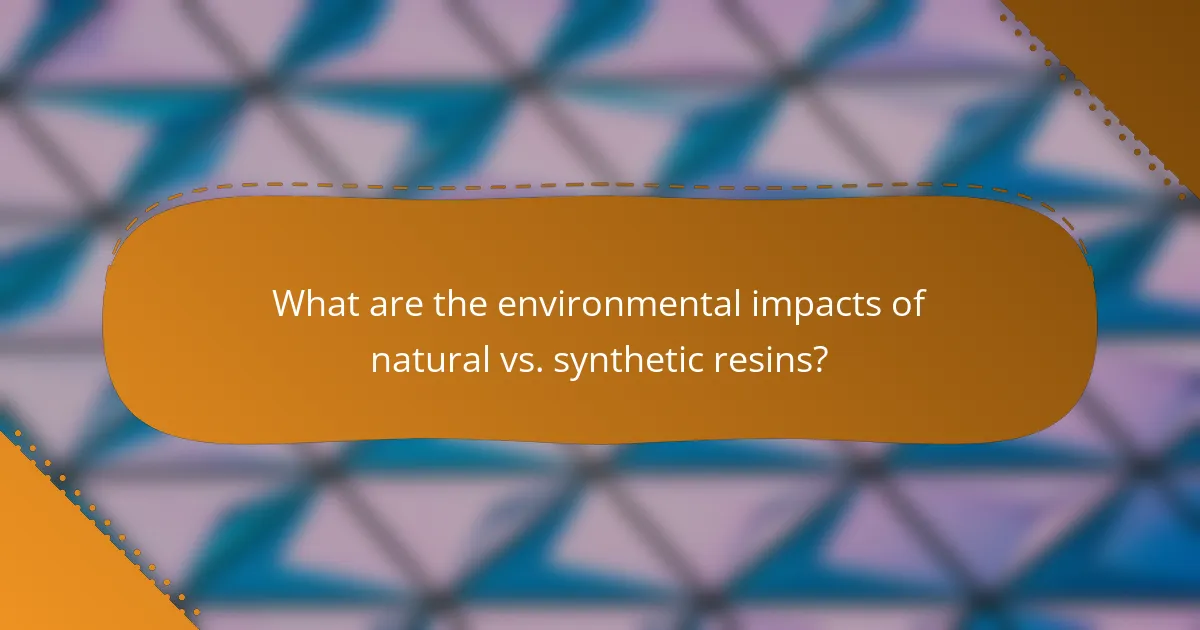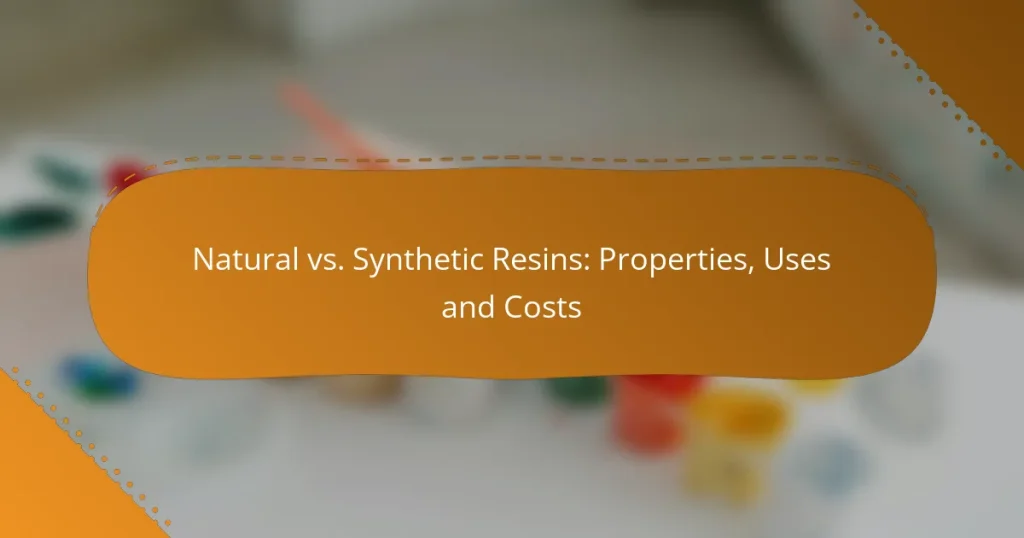Natural and synthetic resins play crucial roles in various industries, each offering distinct properties and benefits. Natural resins, sourced from plant exudates, are prized for their aesthetic qualities and applications in adhesives and coatings. In contrast, synthetic resins are engineered for versatility and durability, making them ideal for a wide range of uses from construction to consumer products.

What are the properties of natural resins?
Natural resins are organic compounds derived from plant exudates, primarily from trees. They possess unique properties that make them suitable for various applications, including adhesives, varnishes, and coatings.
Biodegradable characteristics
Natural resins are inherently biodegradable, breaking down over time through natural processes. This makes them an environmentally friendly option compared to synthetic resins, which can persist in the environment for much longer periods.
The biodegradability of natural resins is influenced by factors such as temperature, moisture, and microbial activity. In suitable conditions, they can decompose within a few months to a couple of years, depending on the specific resin type.
Thermal stability
Natural resins generally exhibit moderate thermal stability, which means they can withstand certain temperature ranges without degrading. However, they may not perform as well as synthetic resins in extreme heat conditions.
For applications requiring high thermal resistance, it is essential to consider the specific type of natural resin being used, as some may have better heat resistance than others. Typical thermal stability ranges for natural resins are around 60-120°C.
Adhesive qualities
Natural resins are known for their excellent adhesive properties, making them ideal for bonding materials in woodworking and crafts. They can create strong bonds that are often more flexible than those formed by synthetic adhesives.
When using natural resins as adhesives, it is crucial to ensure proper surface preparation and application techniques to maximize adhesion. Common natural resins used for adhesives include rosin and shellac.
Natural color variations
Natural resins come in a variety of colors, influenced by their source and processing methods. These color variations can enhance the aesthetic appeal of products, particularly in art and decorative applications.
For example, amber is a well-known natural resin that ranges from yellow to deep brown, while copal can vary from clear to opaque. When selecting a natural resin for a project, consider how its color will complement the final product.

What are the properties of synthetic resins?
Synthetic resins are man-made polymers known for their versatility and durability. They exhibit a range of properties that make them suitable for various applications, from construction to consumer goods.
Durability and strength
Synthetic resins are renowned for their exceptional durability and strength, often outperforming natural alternatives. They can withstand significant stress and impact, making them ideal for structural applications like automotive parts and building materials.
For instance, epoxy resins are commonly used in aerospace and marine industries due to their high tensile strength and resistance to deformation. This durability translates into longer lifespans for products, reducing the need for frequent replacements.
Cost-effectiveness
When considering cost-effectiveness, synthetic resins often provide a more affordable option compared to natural resins. Their production processes can be scaled efficiently, leading to lower costs per unit.
Additionally, the longevity of synthetic resins means that they can offer better value over time, as fewer replacements are needed. This is particularly relevant in industries where budget constraints are critical, such as construction and manufacturing.
Customizable formulations
One of the key advantages of synthetic resins is their customizable formulations. Manufacturers can alter the chemical composition to achieve specific properties, such as flexibility, hardness, or thermal resistance.
This customization allows for tailored solutions that meet precise industry requirements, enhancing performance in applications ranging from electronics to coatings. For example, adding fillers or plasticizers can modify the resin’s characteristics for specific uses.
Resistance to chemicals
Synthetic resins generally exhibit excellent resistance to a wide range of chemicals, including acids, bases, and solvents. This property is crucial in environments where exposure to harsh substances is common, such as laboratories and industrial settings.
For instance, phenolic resins are often used in applications requiring chemical resistance, such as in the production of laboratory equipment. This resistance helps maintain the integrity and safety of products over time, making synthetic resins a preferred choice in many sectors.

How do natural and synthetic resins compare in applications?
Natural and synthetic resins serve diverse applications across various industries, each with unique properties and benefits. Natural resins, derived from plant sources, are often valued for their aesthetic qualities, while synthetic resins are engineered for durability and versatility in construction and industrial uses.
Natural resins in art and crafts
Natural resins, such as amber and copal, are frequently used in art and crafts due to their unique textures and colors. Artists appreciate their ability to create stunning finishes and their compatibility with various pigments. Common applications include varnishes, paints, and jewelry making.
When working with natural resins, consider their drying times and the environmental conditions that may affect them. For instance, some natural resins may take longer to cure in humid environments, so plan accordingly to avoid delays in your projects.
Synthetic resins in construction
Synthetic resins, like epoxy and polyester, are widely utilized in construction for their strength and resistance to environmental factors. These materials are essential for adhesives, coatings, and composite materials used in building structures. Their durability makes them suitable for both residential and commercial applications.
When selecting synthetic resins for construction, consider factors such as curing time, temperature resistance, and chemical exposure. For example, epoxy resins are known for their excellent bonding strength but may require specific temperature conditions to cure effectively.
Industrial uses of both types
Both natural and synthetic resins find extensive use in various industrial applications. Natural resins are often used in the production of specialty chemicals and as additives in manufacturing processes, while synthetic resins dominate in the production of plastics, coatings, and insulation materials.
In industrial settings, the choice between natural and synthetic resins often hinges on performance requirements and cost considerations. Natural resins may be preferred for eco-friendly products, while synthetic options are typically chosen for their consistency and lower production costs. Always evaluate the specific needs of your project to make an informed decision.

What are the costs associated with natural and synthetic resins?
The costs of natural and synthetic resins vary significantly based on factors such as sourcing, production methods, and market demand. Generally, natural resins tend to be more expensive due to their limited availability and labor-intensive extraction processes, while synthetic resins are often cheaper due to mass production capabilities.
Pricing trends for natural resins
Natural resins, such as amber or pine resin, can range from moderate to high prices depending on quality and rarity. For instance, high-quality amber can fetch prices in the hundreds of dollars per kilogram, while more common types may be priced in the tens of dollars per kilogram. Market demand and environmental factors also influence these prices.
As sustainability becomes a priority, the demand for natural resins is increasing, potentially driving prices higher. Additionally, fluctuations in supply due to climate change or harvesting regulations can lead to unpredictable pricing trends.
Cost analysis of synthetic resins
Synthetic resins, including epoxy and polyester, are generally more affordable, often costing between $5 to $20 per kilogram. The lower price point is largely due to the ability to produce these materials at scale using petroleum-based feedstocks. This mass production leads to consistent quality and reduced costs.
However, the market for synthetic resins can be affected by oil prices and environmental regulations aimed at reducing plastic use. As a result, while synthetic resins are typically cheaper, their prices can fluctuate based on external economic factors.
Factors influencing resin pricing
Several factors impact the pricing of both natural and synthetic resins. For natural resins, availability, extraction methods, and environmental regulations are key determinants. Limited sources and the labor-intensive nature of harvesting can drive prices up.
In contrast, synthetic resin pricing is influenced by raw material costs, production efficiency, and market competition. Additionally, innovations in production technology can lead to cost reductions, making synthetic options more appealing over time.
When considering resin purchases, it’s essential to evaluate both the cost and the intended application, as the performance characteristics of natural versus synthetic resins can vary significantly. This assessment will help in making informed decisions based on budget and requirements.

What are the environmental impacts of natural vs. synthetic resins?
The environmental impacts of natural and synthetic resins differ significantly, primarily in terms of their carbon footprints and pollution levels. Natural resins generally have a lower carbon footprint but can still contribute to deforestation, while synthetic resins often lead to higher pollution during production and disposal.
Carbon footprint of natural resins
Natural resins, sourced from trees and plants, tend to have a lower carbon footprint compared to their synthetic counterparts. The production process for natural resins usually requires less energy and fewer chemicals, which helps reduce greenhouse gas emissions. However, the harvesting of these resins can lead to deforestation if not managed sustainably.
When considering the carbon footprint of natural resins, it’s essential to look for sustainably sourced options. Certifications such as FSC (Forest Stewardship Council) can help consumers identify products that minimize environmental impact. Overall, while natural resins are more eco-friendly, responsible sourcing is crucial.
Pollution from synthetic resins
Synthetic resins are typically derived from petrochemicals, and their production can result in significant pollution. The manufacturing process often releases volatile organic compounds (VOCs) and other harmful substances into the air and water, contributing to environmental degradation. Additionally, synthetic resins can take hundreds of years to decompose, leading to long-term pollution issues.
To mitigate the pollution associated with synthetic resins, it is advisable to choose products that comply with environmental regulations, such as REACH (Registration, Evaluation, Authorisation and Restriction of Chemicals) in Europe. Opting for biodegradable or recyclable synthetic options can also help reduce their environmental footprint.

How to choose between natural and synthetic resins?
Choosing between natural and synthetic resins depends on your specific application, budget, and desired properties. Natural resins are often favored for their eco-friendliness and unique aesthetics, while synthetic resins provide consistency and versatility in performance.
Consider the application
The intended use of the resin is crucial in making your choice. Natural resins are commonly used in art, crafts, and traditional applications due to their unique characteristics and historical significance. In contrast, synthetic resins are preferred in industrial applications, such as adhesives, coatings, and composites, where durability and performance are paramount.
Evaluate the properties
Natural resins typically offer a warm, organic look and can be biodegradable, making them suitable for environmentally conscious projects. However, they may have variable properties, such as hardness and viscosity. Synthetic resins, on the other hand, provide consistent characteristics, including strength, chemical resistance, and temperature stability, which can be tailored to meet specific requirements.
Assess the costs
Cost is a significant factor when choosing between natural and synthetic resins. Natural resins can be more expensive due to their sourcing and processing, often ranging from moderate to high prices depending on the type and availability. Synthetic resins generally offer a more cost-effective solution, with prices often lower and more predictable, making them suitable for large-scale production.


